Between
Châtelet and
Beaubourg
1- Place du Châtelet, Châtelet Square
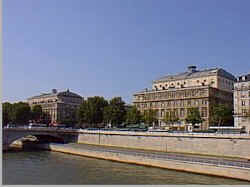 This
square was rearranged in 1808, replacing the old Chatelet fortress which protected the
entrance to Paris until 1802. Redesigned again in the 1860’s by Haussmann, the square was
lined by the Chatelet Theater (théâtre du Châtelet)
and the Theater of the City (théâtre de la Ville)
which was run by Sarah Bernhardt from 1898-1923. This
square was rearranged in 1808, replacing the old Chatelet fortress which protected the
entrance to Paris until 1802. Redesigned again in the 1860’s by Haussmann, the square was
lined by the Chatelet Theater (théâtre du Châtelet)
and the Theater of the City (théâtre de la Ville)
which was run by Sarah Bernhardt from 1898-1923.
Built by Davioud, the two theaters
are characteristic of the discretion desired by the Seine prefecture. With the exception
of their huge, classic facades, they blend into the surrounding architecture. Only the
size of the main performance rooms is apparent. On the side of the Seine, the facades
follow the alignment of the
other buildings. Haussmann wanted his new, large boulevards to be linked to the
city’s central points. From the Sebastopol
Boulevard, one can see the domed Business
Tribunal which cuts off the view from the Island of the Cité.
La tour Saint-Jacques, St-Jacques Tower
The
St. Jacques Tower is the only remnant that remains of the St. Jacques de la Bourcherie
Church which once stood in place of the present St. Jacques Square. The sanctuary, laid
during the Carolingian era, served as an important crossroads en route to the pilgrimage
site of St. Jacques de Compstelle. The statue of the pinnacle is that of a saint. Only the
gothic tower wasn’t destroyed during the Revolution. Built in 1523, the tower
illustrates how the shapes of Middle Ages endured into the Sixteenth Century. It has been
a meteorological station since 1891.
At the base of the Statue of Pascal,
the script recalls that the philosopher renewed his barometric experiments here in
1648 from the Puy de Dome. A Stella pays homage to Gerard de
Nerval (poet) who was found not far from here in 1855.
Rue Saint-Martin which passes in
front of the Beaubourg and the Saint-Jacques Tower is the old "cardo", the
principal North-South route from Lutèce. The quarter didn't become urbanized until the
Eleventh Century with the construction of the Châtelet Fortress in front of the Pont
Neuf. The Fortress disappeared in 1808.
2- Place de l'hôtel de Ville, City Hall Plaza
Until
the Eleventh Century, the present plaza was just a long, rocky shore. In 1141, the
‘water merchants’ created a port to ease the congestion at the Ile de la Cité's
port. The Greve port received boats with provisions such as wheat, wine, hay, wood and
coal. The first municipal authorities, dominated by the ‘water merchants’, set
up a house alongside the Greve Square in 1357. The small square became a place of
celebrations and revolts by the Parisians. From the Twelfth Century until1830 it was also
used as a site for executions. In1830 the square took on its present name. In the
Nineteenth Century, the jobless workers gathered here and gave birth to the expression
‘être en grève’ (to be on strike). Haussmann enlarged the square and gave it
its present name. It became a pedestrian square in 1982.
Hôtel de Ville, City Hall, place de
l'Hôtel de Ville (www)
(tel. 01 42 76 43 43, tours of the rooms tel. 01 42 76 50 49, for guided visits,
every Monday at rue Lobau and porche Rivoli. The main chambers are only visible during
public meetings and municipal councils)
The Parisian
municipality was granted by the King in 1170, and came about from the water
merchant’s corporation. The water merchants had considerable power, their monopoly of
all provisions transported by water was significant because most trade was carried out by
boat. In 1246, St. Louis created the first municipality : the middle class of Paris
elected a municipal magistrate who represented them in front of the King. The head of
their corporation was called the ‘Provost of the Merchants’ and the seal of the
most powerful water merchants was adopted. This famous boat that ‘floats and
doesn’t sink’ (fluctuat nec mergitur) now forms the armories of the City of
Paris. For one century, the meetings were held in the neighboring St. Genevieve Abbey on
the left bank. It was in 1375 that Etienne Marcel, provost of the Merchants, bought a
house that looked onto the small Greve Square. The ‘house of pillars’ was built
in gothic style, decorated with arcades on the ground floor from which it gets its name.
It was rebuilt in the Sixteenth Century, then again in the Seventeenth. Redone over and
over, enlarged and decorated (paintings from Ingres and Delacroix) during the Nineteenth
Century under Louis Philippe, it was burned to the ground in 1871 by the "Commune". It was rebuilt in its original style
in 1882 under a national subscription (by Theodore Ballu and Eduouard Deperthes). Many
nooks and pillars hold the 108 statues of famous Parisians. Above the building’s cap
stand 30 statues representing French cities (-except Strasbourg and Metz.) The
‘clock’s fronton’ decorating the central facade represents many feminine
allegories : the Seine and the Marne (rivers) are framed by Work and Instruction, atop the
City of Paris. The ornate interior with its gildings, woodwork, and chandeliers by
Baccarat all give testimony to the wealth of the Third Republic. The Council of Paris,
which holds its meetings on Mondays, is open to the public. The Mayor of Paris' house is
located next to the quay of the city Hall (quay of the Hotel de Ville)
B.H.V.
(Bazar de l'hôtel de Ville), BHV Department Stores, 52-64 rue de Rivoli
(www)
(open10-7 p.m. except Sunday, Wednesdays until 10:00pm)
The
old Napoleon bazaar which became the city hall bazaar in 1870 is not remarkable for its
architecture. The downstairs however is known to all do-it-yourself handymen
Eglise Saint-Merri, St-Merri Church, 78 rue Saint-Martin
ou 76 rue de la Verrerie
(métro Hôtel de Ville) (tél. 01 42 71 93 93, from
9a.m.-7p.m. daily)
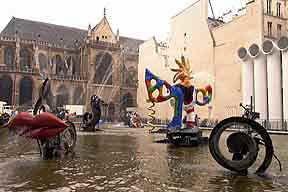 The
abbot of St. Martin of Autun, St. Mederic, was buried in Paris around the year 700. His
name was shortened and given to this chapel, which was built in the Ninth Century and
rebuilt in 1220. Constructed in a flamboyant gothic style, the present church dates from
1552. In the Eighteenth Century, the gothic parts were destroyed and replaced by a baroque
decor. The choir screen and the monumental cloisters which separated the choir from the
nave were destroyed in 1709. The stained glass windows were replaced by clear glass. The
St. Merri gives us a good idea of decoration from the Notre Dame era since the decor is
still intact here. During the Revolution the statues were destroyed, and the church was
turned into a powder factory. In the Nineteenth Century the statues were replaced (1842),
the building restored and the city of Paris had the chapels decorated with paintings. A
small turret located to the left of the facade contains the oldest bell in Paris that
dates from 1331. The
abbot of St. Martin of Autun, St. Mederic, was buried in Paris around the year 700. His
name was shortened and given to this chapel, which was built in the Ninth Century and
rebuilt in 1220. Constructed in a flamboyant gothic style, the present church dates from
1552. In the Eighteenth Century, the gothic parts were destroyed and replaced by a baroque
decor. The choir screen and the monumental cloisters which separated the choir from the
nave were destroyed in 1709. The stained glass windows were replaced by clear glass. The
St. Merri gives us a good idea of decoration from the Notre Dame era since the decor is
still intact here. During the Revolution the statues were destroyed, and the church was
turned into a powder factory. In the Nineteenth Century the statues were replaced (1842),
the building restored and the city of Paris had the chapels decorated with paintings. A
small turret located to the left of the facade contains the oldest bell in Paris that
dates from 1331.
3- Centre Beaubourg-Georges Pompidou, Georges-Pompidou Center, 19 rue Beaubourg (www)
(métro Rambuteau) Open every week day except Tuesday 12:00 p.m. to 10:00 p.m.
Saturday and Sunday 10:00 a.m. to 10:00 p.m. Now closed until the end of December 1999)
(Renzo Piano and Richard Rogers, Architects,www of the architects1977)
(today David Hockney.
Espace/Paysage, until 26 april)
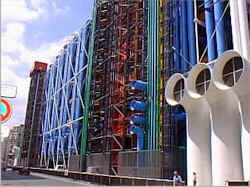 President
Georges Pompidou, a modern art enthusiastic, wanted to build a large contemporary art
museum and open a free library. Though he disapproved of the final design the jury chose,
he accepted their decision. The architects Renzo Piano and Richard Rogers wanted to
construct a building that was familiar like a factory, playful and intriguing "above
all not an intimidating temple of culture." The major constraint was to eliminate all
the interior obstacles so that there would be complete liberty in arranging the interior
space. The architects overcame these constraints by "taking out and exhibiting the
insides of the building on its exterior." The metal circulation ducts are in
different colors: green for water, blue
for heating and air, yellow for electricity, red for the circulation of people and of course the large escalator
in its glass tube. Completed in 1977, Pompidou Center is well integrated into Paris thanks
to its respect for traditional alignment
and its contrast of forms and colors. It attracts 25,000 people per day; far more than
planned. A large part of the center will be closed until December 31, 1999 for
renovations, in order to reorganize the modern art exhibition spaces. The spaces will
almost double because the administration offices are moving to the other side of Rambuteau
Street. The Public Information Library will occupy three levels and will have an
independent entrance. President
Georges Pompidou, a modern art enthusiastic, wanted to build a large contemporary art
museum and open a free library. Though he disapproved of the final design the jury chose,
he accepted their decision. The architects Renzo Piano and Richard Rogers wanted to
construct a building that was familiar like a factory, playful and intriguing "above
all not an intimidating temple of culture." The major constraint was to eliminate all
the interior obstacles so that there would be complete liberty in arranging the interior
space. The architects overcame these constraints by "taking out and exhibiting the
insides of the building on its exterior." The metal circulation ducts are in
different colors: green for water, blue
for heating and air, yellow for electricity, red for the circulation of people and of course the large escalator
in its glass tube. Completed in 1977, Pompidou Center is well integrated into Paris thanks
to its respect for traditional alignment
and its contrast of forms and colors. It attracts 25,000 people per day; far more than
planned. A large part of the center will be closed until December 31, 1999 for
renovations, in order to reorganize the modern art exhibition spaces. The spaces will
almost double because the administration offices are moving to the other side of Rambuteau
Street. The Public Information Library will occupy three levels and will have an
independent entrance.
Musée national d’Art moderne, The National
Museum of Modern Art
This
museum took over the collection from the Museum of Modern Art, which was created in 1937
in the Tokyo Palace. The collection was enriched by other donations and acquisitions, but
it was not exhibited permanently and many of the works were rotated. Now closed, the
museum has paintings by Fauves, the cubists, Bonnard, Matisse, Léger, Kandinski, Klee,
Malévitch, Delaunay, the surrealists, Dubuffet, the Cobra group, Giacometti, etc. Since
1945 the collections are filled with American Abstract Art "new realism", Pop
Art…
The view of Paris from
the "caterpillar" staircase and the cafe terrace on the last floor is very
interesting, although the view is not 360 degrees.
Bibliothèque publique d'information,
The Public Information Library (BPI) (www)
(Every week day except Tuesday 12:00 p.m. to 10:00 p.m. Saturday and Sunday 10:00 a.m.
to 10:00 p.m)
Opened
in 1977 at the same time as the Pompidou center, the innovative principle of this library
was to give access to the largest possible portion of the population. The library is open
to all, and it is free with books in easy access. Since November 1997, a small part of the
library has moved to Brantôme Street in the Horloge quarter.
Atelier Brancusi
At the intersection of the place Beaubourg and
rue Rambuteau
(from noon to 10 p.m. daily except Tuesdays, from 10a.m. to 10p.m. Saturdays and
Sundays)
Constantin Brancusi
lived and worked in his studio located in Impasse Ronsin (15th district now gone) from
1925 to 1957. When he died, the sculptor willed his studio, and the state was obligated to
restore it into a modern art museum. The studio was imperfectly restored at the Palace of
Tokyo, then flooded in the first building of the place Beaubourg. The studio has now been
restored by Renzo Piano who has just reopened it. The studio has sketches as well as the
pure and stylistic sculptures in stone, marble and bronze.
4-
Ircam, 1 place Stravinski (www)
(tel. 01 44 78 48 43, open daily except Tuesdays and Sundays)
(Daniel and Patrick Rubin, Architects, then Renzo Piano)
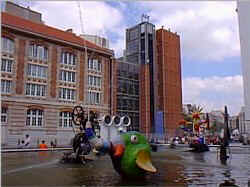 The
‘Institute of Research and Music/Acoustic Coordination’ is divided into three
sectors. The studios, musical creation and research laboratories (on acoustics,
perception) are located underneath the Stravinski Square. The old brick and stone building
is where the documentation (media library offers partitions, sound documents) and pedagogy
sectors are located (Architects Daniel and Patrick Rubin). Finally, the modern extension
by Renzo Piano, built in 1989, houses the general services. The use of brick and discrete
alignment enables the building to mix in with the neighboring architecture, but the pure
and clean shape still stands out. The
‘Institute of Research and Music/Acoustic Coordination’ is divided into three
sectors. The studios, musical creation and research laboratories (on acoustics,
perception) are located underneath the Stravinski Square. The old brick and stone building
is where the documentation (media library offers partitions, sound documents) and pedagogy
sectors are located (Architects Daniel and Patrick Rubin). Finally, the modern extension
by Renzo Piano, built in 1989, houses the general services. The use of brick and discrete
alignment enables the building to mix in with the neighboring architecture, but the pure
and clean shape still stands out.
Fontaine Stravinski, Stravinski Fountain
(Jean Tinguely and Niki de Saint-Phalle, 1983)
Created in 1983, the fountain adds to the ‘street’ entertainment
coming from the Beaubourg center. In the center of the Place, musicians, caricatures and
colorful braiders reign. In front of the fountain musicians, dancers and mimes entertain
the passers-by. The fountain’s iron mobiles were set up by Jean Tinguely, the
‘chicks’ and other colorful characters were made by Niki de Saint Phalle. The
sculptures pay homage to the composer of Petrouchka and the Sacre of Spring.
5- Quartier de l'horloge,
District of the Clock, rues Rambuteau et Brantôme
(JC Bernard and A. Bertrand, Architects,1983)
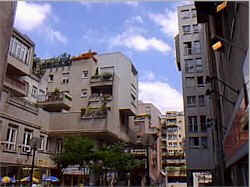 Built at the same time as
the Beaubourg district, the current buildings overtook the small, unhygenic buildings, as
well as old hosiery and dry goods stores. Only the facades of St. Martin Street and four
buildings on Beaubourg Street which date from the beginning of the century were spared.
The new 6- and 7-story buildings are integrated into the traditional framework. The second
floors of these buildings are occupied by a wide variety of activities as well as green
terraces. On the Beaubourg side, the district opens up onto a statue of Zadkine,
representing the flight of Prometheus when he had just robbed the heavens of fire. In the
center, the large clock has the figure,
‘the Defender of Time’ on it. Every hour he fights one of the three monsters
that comes out from the air, the earth or the sea. At noon and 6 p.m., he fights all three
(Jacques Monestier, 1979). Built at the same time as
the Beaubourg district, the current buildings overtook the small, unhygenic buildings, as
well as old hosiery and dry goods stores. Only the facades of St. Martin Street and four
buildings on Beaubourg Street which date from the beginning of the century were spared.
The new 6- and 7-story buildings are integrated into the traditional framework. The second
floors of these buildings are occupied by a wide variety of activities as well as green
terraces. On the Beaubourg side, the district opens up onto a statue of Zadkine,
representing the flight of Prometheus when he had just robbed the heavens of fire. In the
center, the large clock has the figure,
‘the Defender of Time’ on it. Every hour he fights one of the three monsters
that comes out from the air, the earth or the sea. At noon and 6 p.m., he fights all three
(Jacques Monestier, 1979).
6- Musée de la poupée, Doll Museum, impasse
Berthaud, 22 rue Beaubourg, 3rd
(métro Rambuteau)
(tel. 01 42 72 73 11 or 01 42 72 55 90, from 10a.m. to
1p.m. and 2p.m. to 6:30 daily, Thursdays from 8p.m. -10 p.m.)
Prior
to the doll museum, a mechanical museum was located here until1995. The new museum
exhibits a doll and French ‘babies’ collection made out of porcelain from
1860-1960, all of which were collected by Guido and his son Samy Odin. Presented in a
decor that evokes the era of their creation, the dolls have evolved. The
‘Parisians’ from 1860-70 have adult faces and represented the fashion of the
era. It was only after1880 that the first dolls adopted the faces of children and
newborns. The museum organizes workshops for the creation and restoration of porcelain
dolls.
To continue with the Marais on the rue des Francs-Bourgeois
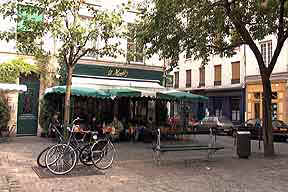 Between Saint-Paul and City Hall Between Saint-Paul and City Hall
(Leave from métro
Saint-Paul...)
(Access
: go by way of rue Caron, rue de Sévigné or rue de Turenne...)
7- Place du marché Sainte-Catherine, St-Catherine Market Square
Of course
the buildings date back to the Eighteenth Century, but the organization of this charming
little square is typical of the Middle Ages. All of the perspectives are closed which
makes it difficult to get to...
8- Eglise Saint-Paul-Saint-Louis, St-Paul-St-Louis Church, 99 rue Saint-Antoine
(tel 01 42 72 30 32, from 8 a.m. to 7 :30 p.m. daily)
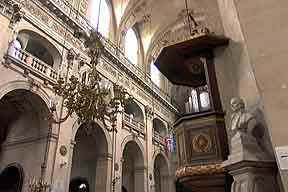 This is
the only Jesuit church in Paris. The Jesuits, militants of the Counter Reform, decided in
the Seventeenth Century to build an impressive church. Begun with the help of Louis XIII
who gave his name to it, the church was finished in 1641. The church was famous for the
richness of its furniture and works of art all of which disappeared during the Revolution.
Today they are on display at the Louvre and in Chantilly. From 1641 to 1762, the church
was at its height : Bousset and Bourdaloue came to read and Madame of Sevigné came to
listen to them; Marc-Antoine Charpentier and Rameau were head of the chapel. The
hearts of
Louis XIII and Louis XIV were preserved for a long time. The church was pillaged during
the Revolution and turned into a book depot for the destroyed convents in the quarter. It
adopted the religious group of Reason. It returned to its religious purpose in 1802 by
adding St. Paul’s name since the St. Paul church had just been destroyed. Baltard was
in charge of restoring it under the Second Empire. This is
the only Jesuit church in Paris. The Jesuits, militants of the Counter Reform, decided in
the Seventeenth Century to build an impressive church. Begun with the help of Louis XIII
who gave his name to it, the church was finished in 1641. The church was famous for the
richness of its furniture and works of art all of which disappeared during the Revolution.
Today they are on display at the Louvre and in Chantilly. From 1641 to 1762, the church
was at its height : Bousset and Bourdaloue came to read and Madame of Sevigné came to
listen to them; Marc-Antoine Charpentier and Rameau were head of the chapel. The
hearts of
Louis XIII and Louis XIV were preserved for a long time. The church was pillaged during
the Revolution and turned into a book depot for the destroyed convents in the quarter. It
adopted the religious group of Reason. It returned to its religious purpose in 1802 by
adding St. Paul’s name since the St. Paul church had just been destroyed. Baltard was
in charge of restoring it under the Second Empire.
The baroque church has a theatrical facade on three floors, two Corinthian ones and a
composite. The interior was inspired by the Gesu church in Rome : the lateral chapels
serve the aisles. The dome was the largest of its time. The neighboring Charlemagne high school has occupied the old
Seventeenth Century Jesuit house since 1802
La rue Saint-Antoine, Saint-Antoine
street
9- Hôtel de Sully, 62 rue Saint-Antoine (www)
(métro Saint-Paul) (Tel
: 01 44 61 20 00, from 9 a.m.-7 p.m. daily, except Mondays and holidays)
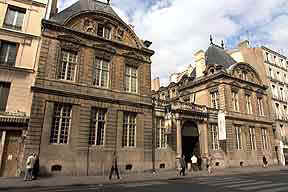 Maximilien
de Bethune, Duke of Sully, grand master of the Artillery and Superintendent of Finances to
Henry IV bought this mansion in 1634. It had been built 10 years earlier. He had it
magnificently decorated in Renaissance style, with the location of the stairwell and an
abundance of decorations. The bas-reliefs on the facades represent the Elements and the
Seasons. Affected by trade at the end of the Eighteenth Century, the mansion was
disfigured by additions that were just recently removed. The restoration was carried out
through the old engravings and blueprints of the house. The National
Treasury of Historical Monuments and Sites moved in and began organizing
exhibitions (www). The book shop
there has many interesting guides of France's heritage ("monuments historiques").
In the back of the garden a passageway leads to the Vosges Square (to number 7). This is the old orange grove built by Sully (see le Marais). Maximilien
de Bethune, Duke of Sully, grand master of the Artillery and Superintendent of Finances to
Henry IV bought this mansion in 1634. It had been built 10 years earlier. He had it
magnificently decorated in Renaissance style, with the location of the stairwell and an
abundance of decorations. The bas-reliefs on the facades represent the Elements and the
Seasons. Affected by trade at the end of the Eighteenth Century, the mansion was
disfigured by additions that were just recently removed. The restoration was carried out
through the old engravings and blueprints of the house. The National
Treasury of Historical Monuments and Sites moved in and began organizing
exhibitions (www). The book shop
there has many interesting guides of France's heritage ("monuments historiques").
In the back of the garden a passageway leads to the Vosges Square (to number 7). This is the old orange grove built by Sully (see le Marais).
Hôtel de Mayenne, Mayenne Mansion, 21 rue Saint-Antoine
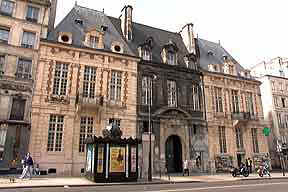 Built
in 1613 for Henry of Mayenne, this mansion resembled the neighboring Sully Mansion. It was
modified in 1709 when the ground floor windows were replaced by arcades, and in 1870 when
it became a Christian school. On the right of the courtyard stands a corbelled turret. Built
in 1613 for Henry of Mayenne, this mansion resembled the neighboring Sully Mansion. It was
modified in 1709 when the ground floor windows were replaced by arcades, and in 1870 when
it became a Christian school. On the right of the courtyard stands a corbelled turret.
Musée de la magie et de la curiosité, Museum of Magic and Curiosity, 11 rue Saint-Paul
(métro Saint-Paul) (tel.
01 42 72 13 26, from 2-7 p.m. Wednesdays, Saturdays, Sundays)
The
museum displays accessories of ‘physical amusement’ from the Seventeenth and
Eighteenth Centuries called ‘prestidigitation.' You can also see real magic shows,
plus instruments that make things disappear, and that contort reality - like the box of
the woman sawed in two. There are also small boxwood pieces that come from ‘physical
amusement’ given to children in the Nineteenth Century, the ‘boxes of
secrets’ or disappearing jewelry, automated figures, brass objects, and malleable
brass objects made in Dinand in Belgium. The other vaulted cellars display the hall of
mirrors; optical illusions based mostly on hollow depths. A movie describes the
paradoxical taste for magic during the Enlightenment.
10- Village Saint-Paul, St-Paul Village
Beginning at the rue St. Paul, you can get to the St. Paul Village, an intricate maze of
inner streets nicely set up by the surrounding antique shops.
If you leave by the other side, by the Jardins St. Paul, you can see two towers of the Philippe Auguste wall dating from 1190 adjacent to the
Charlemagne high school sports field.
11-
Hôtel de Sens, Mansion House of Sens, 1 rue
du Figuier
(métro Saint-Paul,
Pont-Marie)
(from 1:30 -8p.m. daily, except Sundays, Mondays and holidays, from
10a.m. to 8:30p.m. Saturdays)
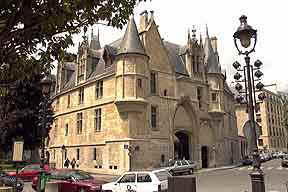 Along
with the House of Cluny, this is one of the rare examples of civil architecture from the
Middle Ages. The mansion was built between 1475-1519 for Tristan de Salazar, archbishop of
Sens who wanted a residence in Paris. Paris didn’t become the seat of the archbishop
until 1623. Before then, Paris depended on the archbishop of Sens who was often a member
of one of the important families like the Guise’s of the Bourbon’s (family of
the king). In the beginning of the Sixteenth Century, Henri IV had his ex-wife, the
fantastic Queen Margot housed here. She was the one who had the fig tree cut down because
it hindered her carriage from passing; the street was named after the tree. Later, the
mansion was rented out for different activities, but it was not maintained. It was in a
state of dilapidation when the city bought it in 1916. The restoration was more or less a
reconstruction. Thus the building kept its irregular medieval marks, its courtyard and its
dungeon from 1475, but the rest of the building wasn’t restored until 1936 through
1962. Along
with the House of Cluny, this is one of the rare examples of civil architecture from the
Middle Ages. The mansion was built between 1475-1519 for Tristan de Salazar, archbishop of
Sens who wanted a residence in Paris. Paris didn’t become the seat of the archbishop
until 1623. Before then, Paris depended on the archbishop of Sens who was often a member
of one of the important families like the Guise’s of the Bourbon’s (family of
the king). In the beginning of the Sixteenth Century, Henri IV had his ex-wife, the
fantastic Queen Margot housed here. She was the one who had the fig tree cut down because
it hindered her carriage from passing; the street was named after the tree. Later, the
mansion was rented out for different activities, but it was not maintained. It was in a
state of dilapidation when the city bought it in 1916. The restoration was more or less a
reconstruction. Thus the building kept its irregular medieval marks, its courtyard and its
dungeon from 1475, but the rest of the building wasn’t restored until 1936 through
1962.
Bibliothèque
Forney, Forney
Library, 1 rue du Figuier
(tél. 01 42 78 14 60, open13.30-20.00 except Sunday
and Monday , Saturday from 10.00-20.30)
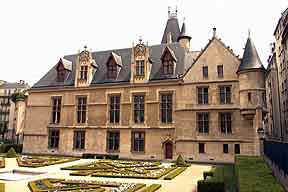 The
Mansion of Sens houses the Forney library, dedicated to decorative art. Founded in 1886
from the legacy of the industrialist, Forney, it became a center for documentation for
Parisian artists. Today it offers to art and architecture lovers, books, periodicals,
slides, posters and fabric samples from the 18th century, furniture drawings and
ironworks, wall paper collections... On the right of the Mansion House of Sens, the formal garden is accessible (by view) by the alleyway
(open 8.30-12.30). This is connected with l'hôtel d'Aumont which houses the administrative tribunal built by François Mansart. The
Mansion of Sens houses the Forney library, dedicated to decorative art. Founded in 1886
from the legacy of the industrialist, Forney, it became a center for documentation for
Parisian artists. Today it offers to art and architecture lovers, books, periodicals,
slides, posters and fabric samples from the 18th century, furniture drawings and
ironworks, wall paper collections... On the right of the Mansion House of Sens, the formal garden is accessible (by view) by the alleyway
(open 8.30-12.30). This is connected with l'hôtel d'Aumont which houses the administrative tribunal built by François Mansart.
On the other side of the rue du figuier, the MIJE Youth Hostel can be reached by passing through the garden, 11 rue du Fauconnier (reception open in the
mornings only).
12-
Maison européenne de la
photographie, European House of Photography, 5-7 rue de Fourcy
(www)
(métro Saint-Paul) (tel. 01 44 78 75 00, from 11a.m. to 8p.m. daily except Mondays and Tuesdays)
(Yves Lion and A Levitt, Architects,1995)
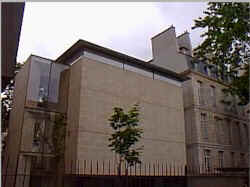 The
European House of Photography has been organizing thematic and monographic exhibitions
since 1995. The exhibition rooms were created in the Eighteenth Century mansion of Henault
de Cantobre, although only a lovely balcony and iron wrought stairwell remain from the
original building. After the suppression of the Nineteenth Century add-ons, it was
enlarged by the architects, Yves Lion and A. Levitt. Their wing was built with stones from
the old mansion. The new additions can be distinguished by their size and cleanliness. The
European House of Photography has been organizing thematic and monographic exhibitions
since 1995. The exhibition rooms were created in the Eighteenth Century mansion of Henault
de Cantobre, although only a lovely balcony and iron wrought stairwell remain from the
original building. After the suppression of the Nineteenth Century add-ons, it was
enlarged by the architects, Yves Lion and A. Levitt. Their wing was built with stones from
the old mansion. The new additions can be distinguished by their size and cleanliness.
The Saint-Gervais quarter has guarded traces of its medieval streets: stroll along rue
François-Miron and rue des Barres...
Hôtel de Beauvais,
Beauvais House, 68 rue François Miron
The
construction of this building commenced in 1655 for Mrs. Beauvais, private maid to Anne of
Austria. The house replaced a building whose old and beautiful gothic cellars are still
standing. It is from its balcony that the queen mother, Mazarin Turenne helped Louis XIV
enter Paris in 1660 with his young wife Marie-Therese. Later, the Ambassador to Baveria
acquired the hotel and put up the Mozart family here in 1763. The land is irregular and
the building is an original design as a result, especially the semi-oval courtyard. Five
grotesque mask doors and the small decorative masks correspond to the old stables. The
wrought iron staircase is also remarkable. But nothing is left of the luxurious,
Eighteenth Century interior decoration.
The mansion has been one of Paris' administrative courts
for the past few years.
Maison de l'association pour la
sauvegarde et la mise en valeur du Paris historique, Association for
safeguarding and valuing historic Paris, 44-46 rue François Miron
(tel. 01 48 87 74 31, open 14.00-18.00, Saturday and
Sunday 2:00-7:30)
Dating from the end of the Sixteenth Century, the house was restored by the
members of the association, who also found the original state of the little cour and the
cellar of 1250. The association fights to prevent destruction of historic buildings, and
often organizes interesting expositions and guided tours of old Paris. (In front of...)
Maisons médiévales, Medieval Houses,
11-13 rue François Miron
The
houses were restored in 1967 in order to discover the original Sixteenth Century
construction. In fact, the Royal Edict of 1607 had ordered to be covered in order to avoid
fires. The two houses with a medieval allure appeared with their wooden frames.
(To the left is the rue Geoffroy..)
Mémorial du martyr juif inconnu, Memorial of the Unknown Jewish Martyr, 17 rue Geoffroy-l'Asnier
(métro Saint-Paul, Pont-Marie) (tel. 01 44 72 42 77, from
10a.m. to 1p.m. and 2p.m. to 6p.m. daily except Saturdays)
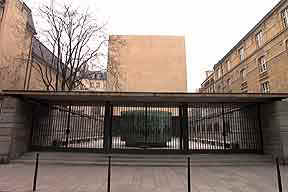 Created in 1956, the tomb of the unknown martyr is located in a crypt under
the Church's front courtyard. Behind it stands the Jewish Documentation Center of Paris, a
four story building dressed in marble. Created in 1956, the tomb of the unknown martyr is located in a crypt under
the Church's front courtyard. Behind it stands the Jewish Documentation Center of Paris, a
four story building dressed in marble.
The place Baudoyer was the
object of protests before the construction of a new parking lot, which revealed a
Merovingien building and sculptures dating from the 5th-7th Centuries.
Towards the Seine, along rue des Barres (13) you can see a beautiful view of the Saint-Gervais church’s
chevet. The little terrace looking onto Medieval Street is a nice place to rest.
Eglise Saint-Gervais, St-Gervais Church, place Saint-Gervais
(métro Hôtel de Ville) (tel. 01 42 72 64 99, from 6
a.m. to 9 p.m. daily)
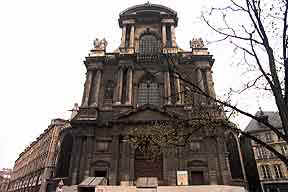 An elm sat in the St. Gervais square.
Replanted in 1912, it recalls the tradition of the judges who used to sit under elm trees
to pronounce their judgments. Traces of this practice can be found in the surroundings:
the balconies of numbers 2 and 14 of François-Miron Street date back to 1732 and
are decorated with a wrought iron elm, particularly that of number 14. The St. Gervais
Church is built atop of a Sixth Century sanctuary dedicated to the martyr brothers St.
Gervais and St. Protais whose relics were found in Milan. The present church dates from
the Sixteenth and Seventeenth Centuries. Louis XIII laid the first rock of the facade in
July 1616, where three antique orders overlay on the top floor: Doric, Ionic and
Corinthian. Marie of Rabutin Chantal was married here in 1644 to the Marquis of Sevigne.
In addition, people like Scarron or Philippe of Champaigne were buried here. The Couperin
organs, from the powerful music dynasty of the Seventeenth Century, were restored to their
original state in 1974. During the Revolution, the tombs were desecrated, the statues
destroyed and the church was transformed into a youth temple. In the Nineteenth Century,
the city of Paris had the interiors of the chapels redone, new statues were put in place,
and the stained glass windows were restored. In 1918, a German shell killed more than a
hundred people when it hit and destroyed a part of the vault. Since 1975, the church has
served the brothers and nuns of the Monastic Brotherhood of Jerusalem which celebrates
mass daily at 7 a.m. 12:30 and 6 p.m. and every Sunday at 11 a.m. An elm sat in the St. Gervais square.
Replanted in 1912, it recalls the tradition of the judges who used to sit under elm trees
to pronounce their judgments. Traces of this practice can be found in the surroundings:
the balconies of numbers 2 and 14 of François-Miron Street date back to 1732 and
are decorated with a wrought iron elm, particularly that of number 14. The St. Gervais
Church is built atop of a Sixth Century sanctuary dedicated to the martyr brothers St.
Gervais and St. Protais whose relics were found in Milan. The present church dates from
the Sixteenth and Seventeenth Centuries. Louis XIII laid the first rock of the facade in
July 1616, where three antique orders overlay on the top floor: Doric, Ionic and
Corinthian. Marie of Rabutin Chantal was married here in 1644 to the Marquis of Sevigne.
In addition, people like Scarron or Philippe of Champaigne were buried here. The Couperin
organs, from the powerful music dynasty of the Seventeenth Century, were restored to their
original state in 1974. During the Revolution, the tombs were desecrated, the statues
destroyed and the church was transformed into a youth temple. In the Nineteenth Century,
the city of Paris had the interiors of the chapels redone, new statues were put in place,
and the stained glass windows were restored. In 1918, a German shell killed more than a
hundred people when it hit and destroyed a part of the vault. Since 1975, the church has
served the brothers and nuns of the Monastic Brotherhood of Jerusalem which celebrates
mass daily at 7 a.m. 12:30 and 6 p.m. and every Sunday at 11 a.m.
Maison des compagnons du devoir, House of the Companions of Duty, 1 place Saint-Gervais
(tel. 01 44 78 22 50)
Visit the masterpieces of carpentry, stone cutting and carrosserie.
Arsenal, Ile Saint-Louis and
Notre-Dame
Quarter
of the l'Arsenal
In 1352 the Celestines,
Benedictine monks, opened a monastery at the level of the rue de l'Arsenal. It quickly
became rich due to its proximity to the royal residences of Saint-Paul and Tournelles. In
1512 however, the king took back the cannon shops which had just been moved to the City at
the edge of the Seine. After its explosion in 1538, the Royal Arsenal was rebuilt by
Philibert Delorme, but the fabrication of weapons and gun powder was transferred to the
Salpertriere, in the Seventeenth Century.
14- Bibliothèque de l'Arsenal, Arsenal
Library, 1 rue de Sully, rue de
l'arsenal
(métro Sully-Morland)
(entrance on the place Teilhard de Chardin , tel. 01 42 76 33 97 ou 01 42 72 19 09 from 10
a.m. to 5 p.m. daily, except Sundays and holidays)
At
the end of the Fourteenth Century, the royal arsenal occupied one of the towers of the
Philippe V wall located close to the river. In July 1538, lightening struck the tower
filled with weapons and ammunition which in turn exploded. It destroyed most of the house
in the quarter.
Today we can still see the canons from Morland Boulevard. Built in 1594 for the Duke of
Sully, the grand master of the Artillery and superintendent of finances, the old residence
of the grand masters was embellished in 1745. The austere facade contrasts with the
magnificent interior decorations. At the end of the Eighteenth Century, the Marquis of
Paulmy of Argenson, grand master of the Artillery gathered Medieval works, when the Middle
Ages were still considered an obscure epoch. Completed by other aristocratic collections,
the library was also embellished by the archives of the Bastille and by the confiscated
books of the convents. The library was opened to the public in 1797. It possesses numerous
manuscripts from the Middle Ages especially the miniatures (writings) and works dedicated
to the art of performance. There is currently a public debate about whether to
redistribute these collections to the National Library in Tolbiac.
(On the other side of
the rue de Sully, also visible from the boulevard Henri IV...)
Caserne des Célestins, Celestines Barracks
This
building housed the cavalry of the Republican Guard, and was constructed in 1892 in place
of the gardens of the old monastery.
15- Pavillon de l'arsenal, Pavilion of the Arsenal, 21 boulevard Morland
(métro Sully-Morland)
(tel 01 42 76 33 97, from 10:30-6:30p.m. daily except Mondays and holidays, from
11-7p.m. Sundays)
(1879, rehabilitated by A. Clément, B. Reichen et P. Robert,
1988)
(Exposition place on architectural and
urban projects in Paris)
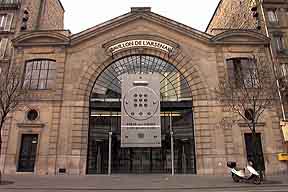 The information center for city planning and
architecture in Paris is located in this building, which was originally constructed in1878
to display the paintings of a rich wood merchant. Transformed later into a Samaritan
studio, the building was bought by the city in 1954. Redone by A. Clement, B. Reichen and
P. Robert in 1988, the center now offers three floors of exhibits. The information center for city planning and
architecture in Paris is located in this building, which was originally constructed in1878
to display the paintings of a rich wood merchant. Transformed later into a Samaritan
studio, the building was bought by the city in 1954. Redone by A. Clement, B. Reichen and
P. Robert in 1988, the center now offers three floors of exhibits.
The ground floor opens with a large model of Paris (1/2000th its real size). The recent
construction in the city is depicted by drawings and models. The second floor is dedicated
to traveling exhibitions, the third floor presents projects submitted for contests
overseen by the city of Paris. In front of the pavilion, a statue by d'Ipousteguy
represents the poet Rimbaud, 'l'homme aux
semelles de vent' according to the words of Verlaine, another poet, and interpreted by the
sculptor... (‘the man which shoes are in front of', 'devant')
Square
Henri-Galli: this encloses a corner of stones
from the Bastille, brought up to date since the improvements of the metro.
(Cross the pont de Sully towards the Ile Saint-Louis...)
16- Ile Saint-Louis
Before
1614, there were just two green islands, the Ile aux Vaches (Island of Cows) and Ile Notre
Dame (Notre Dame Island). The contractor, Marie, was
given the job of city planning. He began with the bridge which now carries his name. The
bridge was completed in 1630, and held 50 houses. The work progressed too slowly and Marie
was replaced by a different team under the architect le Vau. The two islands were united
and surrounded with stone quays and streets in a rectangular pattern. In all, a regular
city layout was established, which was new for the times. The first inhabitants, artisans
and merchants, moved into the two long main streets. More opulent mansions were built
along the quays due to its view of the Seine. Today the district is calm and dignified
surprisingly well kept from invading souvenir shops and noisy crowds
Eglise Saint-Louis-en-l'Ile, Church of St-Louis-en-l’Ile, 19 bis rue Saint-Louis-en-l'Ile
(métro Pont Marie) (tél. 01 46 10 15 00, from 9 a.m.
to noon and 3-7 p.m. daily except Mondays, from 9:00 to 1 p.m. Sundays)
In
1644 a church replaced the small chapel built by the first inhabitants of Saint Louis
island. Built from the plans of le Vau, the church was slowly enlarged but went
unconsecrated until 1726. The Revolution closed the church and took its works of art which
were partly recovered later. In the Nineteenth Century, the Abbot Bousset, parish priest
from 1864-1888 helped to enhance the church and the city of Paris by ordering 28 paintings
that now decorate the lateral chapels. In alignment with the street and facing the east,
the church only has one regular entranceway, but two large wooden doors open onto the
street. A clock points the building out like a sign. The interior is in a typical
religious baroque style. Concerts take place here
almost every evening in the summer.
Musée Adam Mickiewicz, Adam
Mickiewicz Museum, 6 quai d'Orléans
(métro Pont Marie) (tel. 01 43 54 35 61, from 2-6p.m. Thursdays, Closed from July
15-31; Christmas and Easter, guided tours every hour)
Set
up in the Polish library in the Parish, the museum was created in 1903 by Adam
Mickiewicz’s son. The Romantic Polish poet of the Nineteenth Century often expressed
his elated, patriotic feelings. The museum has documents and souvenirs of the poet and of
Romanticism. One whole room is dedicated to Chopin and to Biegas, a painter from the
beginning of the Twentieth Century.
(Cross the pont Saint-Louis towards the Ile
de la Cité...)
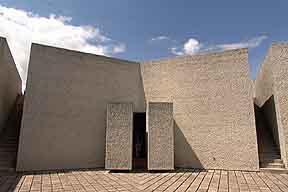 17- Square de l'Ile-de-France,
quai de l'Archevêché 17- Square de l'Ile-de-France,
quai de l'Archevêché
(from 10 a.m.-noon and 2-5p.m. daily)
Located at the eastern tip of the Island of the Cité, the square has been a public
garden since the old morgue was removed. The emotional deportation
memorial was built by G. Henri Pingusson in 1962.
18- Notre-Dame de Paris
(métro Cité, Saint-Michel-Notre-Dame) (tel. 01 43 29 50 40)
(Cathedral Hours: from 8 a.m. to 6:45
p.m. daily, ,closed Saturdays from 12:30 -2 p.m. Choir
Hours: from 10:30-noon and 2 p.m.-5:30 p.m. daily. Tour
Times (on foot): from 9:30 a.m.- 7 p.m. from April to October, from 10 a.m-5:30 p.m. from
November-March Museum Hours : from 2:30-6pm
Wednesday, Saturday, Sunday. Guided Tour
Times (01 42 34 56 10): at noon Monday-Friday, at 2:30 Saturdays
Concert Times (free): at 5:30pm every Sunday)
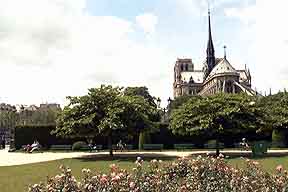 The
bishop, Maurice of Sully, decided in 1160 to construct an immense building to replace the
two old, small churches. Under construction until 1330, the work was begun by an architect
whose name remains unknown today. In fact, artists were anonymous servants of God who were
not recognized as they are today until the Renaissance. Built in the same style as Saint
Denis, Notre Dame is the last of the tribunal cathedrals with high galleries located above
the lateral naves. Beginning in the Fifteenth Century, the Renaissance flowered by
returning to antique art. But the classicism of the Seventeenth Century invented the
pejorative expression ‘gothic’ (they called it ‘ogival’), which
altered the cathedral. At the request of Louis XIV, the architect Robert de Cotte
destroyed the choir screen and replaced it with lavish decor. The doorway is horned to
allow the passage of the monumental canopy processions. The following century, the stained
glass windows were replaced with clear glass. The Revolution attacked the symbols of
religion (doorway statues) and the monarchy (the kings of Juda of the facade that the
people always thought were the kings of France), the inside was pillaged. Notre Dame was
consecrated to the worship of the goddess of Reason. In the Nineteenth Century,
‘Notre Dame of Paris’ became a novel by Victor Hugo in 1831 and it contributed
to return to favor of the Middle Ages. Restoration of Notre-Dame was begun in 1844,
carried out mostly by Viollet le Duc. Hesitating between a new nave faithfully restored in
either the likeness of the Twelfth or the Thirteenth Century, he finally decided to
juxtapose the two eras. The
bishop, Maurice of Sully, decided in 1160 to construct an immense building to replace the
two old, small churches. Under construction until 1330, the work was begun by an architect
whose name remains unknown today. In fact, artists were anonymous servants of God who were
not recognized as they are today until the Renaissance. Built in the same style as Saint
Denis, Notre Dame is the last of the tribunal cathedrals with high galleries located above
the lateral naves. Beginning in the Fifteenth Century, the Renaissance flowered by
returning to antique art. But the classicism of the Seventeenth Century invented the
pejorative expression ‘gothic’ (they called it ‘ogival’), which
altered the cathedral. At the request of Louis XIV, the architect Robert de Cotte
destroyed the choir screen and replaced it with lavish decor. The doorway is horned to
allow the passage of the monumental canopy processions. The following century, the stained
glass windows were replaced with clear glass. The Revolution attacked the symbols of
religion (doorway statues) and the monarchy (the kings of Juda of the facade that the
people always thought were the kings of France), the inside was pillaged. Notre Dame was
consecrated to the worship of the goddess of Reason. In the Nineteenth Century,
‘Notre Dame of Paris’ became a novel by Victor Hugo in 1831 and it contributed
to return to favor of the Middle Ages. Restoration of Notre-Dame was begun in 1844,
carried out mostly by Viollet le Duc. Hesitating between a new nave faithfully restored in
either the likeness of the Twelfth or the Thirteenth Century, he finally decided to
juxtapose the two eras.
The paved stones of the
parvis indicate the layout of the houses as they once were during the Middle Ages, and
before their destruction by Haussmann.
Their presence accentuated the size and height of the original cathedral. One can also see
the famous ‘point zero’ (starting point) of
the roads of France.
Associations of the 4th Arrondissement
Mayor
and Town Hall
Lucien Finel, 2 place Baudoyer, 75 181 Paris cedex 04, métro Hôtel de
Ville, tel 01 42 74 20 04
Statistical Table
Statistiques du recensement de 1990
Sondage de l'INSEE au 1/4 |
Chiffres du 4è |
Chiffres de Paris |
Chiffres de l'agglomération
parisienne |
| Population totale |
32 255 |
2 151 245 |
9 316 656 |
Population par âge (en %)
0-19 ans
20-39 ans
40-59 ans
60-74 ans
+ de 75 ans |
15,7
37,2
25,7
12,7
8,7 |
18,6
35,9
24,7
12,2
8,5 |
25,5
33,8
24,7
10,2
5,7 |
Familles (couples et
enfants)
dont enfants
Personnes habitant seules (en % des ménages)
Nombre de personnes par ménage |
20 128
6 440
54,5
1,78 |
1 423 932
491 292
49,8
1,92 |
7 486 068
2 920 272
33,2
2,41 |
Taux d'activité (en %)
dont chomeurs |
61
8,8 |
60,9
9,7 |
62,5
9 |
Catégories socio-professionnelles des
ménages (selon personne de référence) (en %)
Agriculteurs exploitants
Artisans, commerçants, chefs d'entreprises
Cadres professions intellectuelles sup.
Professions intermédiaires
Employés
Ouvriers
Retraités
Autres (élèves, étudiants, "au foyer") |
0
6,7
28,9
12,8
11
6,8
23,2
10,6 |
0
5,5
23,4
13,9
13,8
10,5
23,4
9,4 |
0,1
5,3
18,4
16,3
14,2
17,4
22,3
6,0 |
Statut d'occupation du logement
par les ménages (en %)
Propriétaires-occupants
Locataires
Logés gratuitement
Logements sans confort
___ (sans salle de bain ni WC intérieurs) |
28
58,5
13,5
10 |
28,3
63,0
8,7
8,1 |
40,2
54,0
5,8
3,9 |
Ménages ne disposant pas de voitures (en %)
Actifs travaillant à Paris
___ (même commune pour l'agglomération) |
59,4
76,4 |
53,7
72,9 |
34,5
33,9 |
Internet sites
Comittees
of the Quarter: local news, information and archives
The
antique web: photos of the old Marais around Saint-Paul
L'Ile Saint-Louis
: les quais, les rues, les ponts, l'histoire, un petit tour en images, les commerces
de l'Ile |
 The
Mansion of Sens houses the Forney library, dedicated to decorative art. Founded in 1886
from the legacy of the industrialist, Forney, it became a center for documentation for
Parisian artists. Today it offers to art and architecture lovers, books, periodicals,
slides, posters and fabric samples from the 18th century, furniture drawings and
ironworks, wall paper collections... On the right of the Mansion House of Sens, the formal garden is accessible (by view) by the alleyway
(open 8.30-12.30). This is connected with l'hôtel d'Aumont which houses the administrative tribunal built by François Mansart.
The
Mansion of Sens houses the Forney library, dedicated to decorative art. Founded in 1886
from the legacy of the industrialist, Forney, it became a center for documentation for
Parisian artists. Today it offers to art and architecture lovers, books, periodicals,
slides, posters and fabric samples from the 18th century, furniture drawings and
ironworks, wall paper collections... On the right of the Mansion House of Sens, the formal garden is accessible (by view) by the alleyway
(open 8.30-12.30). This is connected with l'hôtel d'Aumont which houses the administrative tribunal built by François Mansart.
 Created in 1956, the tomb of the unknown martyr is located in a crypt under
the Church's front courtyard. Behind it stands the Jewish Documentation Center of Paris, a
four story building dressed in marble.
Created in 1956, the tomb of the unknown martyr is located in a crypt under
the Church's front courtyard. Behind it stands the Jewish Documentation Center of Paris, a
four story building dressed in marble.
 An elm sat in the St. Gervais square.
Replanted in 1912, it recalls the tradition of the judges who used to sit under elm trees
to pronounce their judgments. Traces of this practice can be found in the surroundings:
the balconies of numbers 2 and 14 of François-Miron Street date back to 1732 and
are decorated with a wrought iron elm, particularly that of number 14. The St. Gervais
Church is built atop of a Sixth Century sanctuary dedicated to the martyr brothers St.
Gervais and St. Protais whose relics were found in Milan. The present church dates from
the Sixteenth and Seventeenth Centuries. Louis XIII laid the first rock of the facade in
July 1616, where three antique orders overlay on the top floor: Doric, Ionic and
Corinthian. Marie of Rabutin Chantal was married here in 1644 to the Marquis of Sevigne.
In addition, people like Scarron or Philippe of Champaigne were buried here. The Couperin
organs, from the powerful music dynasty of the Seventeenth Century, were restored to their
original state in 1974. During the Revolution, the tombs were desecrated, the statues
destroyed and the church was transformed into a youth temple. In the Nineteenth Century,
the city of Paris had the interiors of the chapels redone, new statues were put in place,
and the stained glass windows were restored. In 1918, a German shell killed more than a
hundred people when it hit and destroyed a part of the vault. Since 1975, the church has
served the brothers and nuns of the Monastic Brotherhood of Jerusalem which celebrates
mass daily at 7 a.m. 12:30 and 6 p.m. and every Sunday at 11 a.m.
An elm sat in the St. Gervais square.
Replanted in 1912, it recalls the tradition of the judges who used to sit under elm trees
to pronounce their judgments. Traces of this practice can be found in the surroundings:
the balconies of numbers 2 and 14 of François-Miron Street date back to 1732 and
are decorated with a wrought iron elm, particularly that of number 14. The St. Gervais
Church is built atop of a Sixth Century sanctuary dedicated to the martyr brothers St.
Gervais and St. Protais whose relics were found in Milan. The present church dates from
the Sixteenth and Seventeenth Centuries. Louis XIII laid the first rock of the facade in
July 1616, where three antique orders overlay on the top floor: Doric, Ionic and
Corinthian. Marie of Rabutin Chantal was married here in 1644 to the Marquis of Sevigne.
In addition, people like Scarron or Philippe of Champaigne were buried here. The Couperin
organs, from the powerful music dynasty of the Seventeenth Century, were restored to their
original state in 1974. During the Revolution, the tombs were desecrated, the statues
destroyed and the church was transformed into a youth temple. In the Nineteenth Century,
the city of Paris had the interiors of the chapels redone, new statues were put in place,
and the stained glass windows were restored. In 1918, a German shell killed more than a
hundred people when it hit and destroyed a part of the vault. Since 1975, the church has
served the brothers and nuns of the Monastic Brotherhood of Jerusalem which celebrates
mass daily at 7 a.m. 12:30 and 6 p.m. and every Sunday at 11 a.m.  The
bishop, Maurice of Sully, decided in 1160 to construct an immense building to replace the
two old, small churches. Under construction until 1330, the work was begun by an architect
whose name remains unknown today. In fact, artists were anonymous servants of God who were
not recognized as they are today until the Renaissance. Built in the same style as Saint
Denis, Notre Dame is the last of the tribunal cathedrals with high galleries located above
the lateral naves. Beginning in the Fifteenth Century, the Renaissance flowered by
returning to antique art. But the classicism of the Seventeenth Century invented the
pejorative expression ‘gothic’ (they called it ‘ogival’), which
altered the cathedral. At the request of Louis XIV, the architect Robert de Cotte
destroyed the choir screen and replaced it with lavish decor. The doorway is horned to
allow the passage of the monumental canopy processions. The following century, the stained
glass windows were replaced with clear glass. The Revolution attacked the symbols of
religion (doorway statues) and the monarchy (the kings of Juda of the facade that the
people always thought were the kings of France), the inside was pillaged. Notre Dame was
consecrated to the worship of the goddess of Reason. In the Nineteenth Century,
‘Notre Dame of Paris’ became a novel by Victor Hugo in 1831 and it contributed
to return to favor of the Middle Ages. Restoration of Notre-Dame was begun in 1844,
carried out mostly by Viollet le Duc. Hesitating between a new nave faithfully restored in
either the likeness of the Twelfth or the Thirteenth Century, he finally decided to
juxtapose the two eras.
The
bishop, Maurice of Sully, decided in 1160 to construct an immense building to replace the
two old, small churches. Under construction until 1330, the work was begun by an architect
whose name remains unknown today. In fact, artists were anonymous servants of God who were
not recognized as they are today until the Renaissance. Built in the same style as Saint
Denis, Notre Dame is the last of the tribunal cathedrals with high galleries located above
the lateral naves. Beginning in the Fifteenth Century, the Renaissance flowered by
returning to antique art. But the classicism of the Seventeenth Century invented the
pejorative expression ‘gothic’ (they called it ‘ogival’), which
altered the cathedral. At the request of Louis XIV, the architect Robert de Cotte
destroyed the choir screen and replaced it with lavish decor. The doorway is horned to
allow the passage of the monumental canopy processions. The following century, the stained
glass windows were replaced with clear glass. The Revolution attacked the symbols of
religion (doorway statues) and the monarchy (the kings of Juda of the facade that the
people always thought were the kings of France), the inside was pillaged. Notre Dame was
consecrated to the worship of the goddess of Reason. In the Nineteenth Century,
‘Notre Dame of Paris’ became a novel by Victor Hugo in 1831 and it contributed
to return to favor of the Middle Ages. Restoration of Notre-Dame was begun in 1844,
carried out mostly by Viollet le Duc. Hesitating between a new nave faithfully restored in
either the likeness of the Twelfth or the Thirteenth Century, he finally decided to
juxtapose the two eras.
 This
square was rearranged in 1808, replacing the old Chatelet fortress which protected the
entrance to Paris until 1802. Redesigned again in the 1860’s by
This
square was rearranged in 1808, replacing the old Chatelet fortress which protected the
entrance to Paris until 1802. Redesigned again in the 1860’s by  The
abbot of St. Martin of Autun, St. Mederic, was buried in Paris around the year 700. His
name was shortened and given to this chapel, which was built in the Ninth Century and
rebuilt in 1220. Constructed in a flamboyant gothic style, the present church dates from
1552. In the Eighteenth Century, the gothic parts were destroyed and replaced by a baroque
decor. The choir screen and the monumental cloisters which separated the choir from the
nave were destroyed in 1709. The stained glass windows were replaced by clear glass. The
St. Merri gives us a good idea of decoration from the Notre Dame era since the decor is
still intact here. During the Revolution the statues were destroyed, and the church was
turned into a powder factory. In the Nineteenth Century the statues were replaced (1842),
the building restored and the city of Paris had the chapels decorated with paintings. A
small turret located to the left of the facade contains the oldest bell in Paris that
dates from 1331.
The
abbot of St. Martin of Autun, St. Mederic, was buried in Paris around the year 700. His
name was shortened and given to this chapel, which was built in the Ninth Century and
rebuilt in 1220. Constructed in a flamboyant gothic style, the present church dates from
1552. In the Eighteenth Century, the gothic parts were destroyed and replaced by a baroque
decor. The choir screen and the monumental cloisters which separated the choir from the
nave were destroyed in 1709. The stained glass windows were replaced by clear glass. The
St. Merri gives us a good idea of decoration from the Notre Dame era since the decor is
still intact here. During the Revolution the statues were destroyed, and the church was
turned into a powder factory. In the Nineteenth Century the statues were replaced (1842),
the building restored and the city of Paris had the chapels decorated with paintings. A
small turret located to the left of the facade contains the oldest bell in Paris that
dates from 1331. President
Georges Pompidou, a modern art enthusiastic, wanted to build a large contemporary art
museum and open a free library. Though he disapproved of the final design the jury chose,
he accepted their decision. The architects Renzo Piano and Richard Rogers wanted to
construct a building that was familiar like a factory, playful and intriguing "above
all not an intimidating temple of culture." The major constraint was to eliminate all
the interior obstacles so that there would be complete liberty in arranging the interior
space. The architects overcame these constraints by "taking out and exhibiting the
insides of the building on its exterior." The metal circulation ducts are in
different colors: green for water, blue
for heating and air, yellow for electricity, red for the circulation of people and of course the large escalator
in its glass tube. Completed in 1977, Pompidou Center is well integrated into Paris thanks
to its respect for traditional
President
Georges Pompidou, a modern art enthusiastic, wanted to build a large contemporary art
museum and open a free library. Though he disapproved of the final design the jury chose,
he accepted their decision. The architects Renzo Piano and Richard Rogers wanted to
construct a building that was familiar like a factory, playful and intriguing "above
all not an intimidating temple of culture." The major constraint was to eliminate all
the interior obstacles so that there would be complete liberty in arranging the interior
space. The architects overcame these constraints by "taking out and exhibiting the
insides of the building on its exterior." The metal circulation ducts are in
different colors: green for water, blue
for heating and air, yellow for electricity, red for the circulation of people and of course the large escalator
in its glass tube. Completed in 1977, Pompidou Center is well integrated into Paris thanks
to its respect for traditional  The
‘Institute of Research and Music/Acoustic Coordination’ is divided into three
sectors. The studios, musical creation and research laboratories (on acoustics,
perception) are located underneath the Stravinski Square. The old brick and stone building
is where the documentation (media library offers partitions, sound documents) and pedagogy
sectors are located (Architects Daniel and Patrick Rubin). Finally, the modern extension
by Renzo Piano, built in 1989, houses the general services. The use of brick and discrete
alignment enables the building to mix in with the neighboring architecture, but the pure
and clean shape still stands out.
The
‘Institute of Research and Music/Acoustic Coordination’ is divided into three
sectors. The studios, musical creation and research laboratories (on acoustics,
perception) are located underneath the Stravinski Square. The old brick and stone building
is where the documentation (media library offers partitions, sound documents) and pedagogy
sectors are located (Architects Daniel and Patrick Rubin). Finally, the modern extension
by Renzo Piano, built in 1989, houses the general services. The use of brick and discrete
alignment enables the building to mix in with the neighboring architecture, but the pure
and clean shape still stands out. Built at the same time as
the Beaubourg district, the current buildings overtook the small, unhygenic buildings, as
well as old hosiery and dry goods stores. Only the facades of St. Martin Street and four
buildings on Beaubourg Street which date from the beginning of the century were spared.
The new 6- and 7-story buildings are integrated into the traditional framework. The second
floors of these buildings are occupied by a wide variety of activities as well as green
terraces. On the Beaubourg side, the district opens up onto a statue of Zadkine,
representing the flight of Prometheus when he had just robbed the heavens of fire. In the
center, the large clock has the figure,
‘the Defender of Time’ on it. Every hour he fights one of the three monsters
that comes out from the air, the earth or the sea. At noon and 6 p.m., he fights all three
(Jacques Monestier, 1979).
Built at the same time as
the Beaubourg district, the current buildings overtook the small, unhygenic buildings, as
well as old hosiery and dry goods stores. Only the facades of St. Martin Street and four
buildings on Beaubourg Street which date from the beginning of the century were spared.
The new 6- and 7-story buildings are integrated into the traditional framework. The second
floors of these buildings are occupied by a wide variety of activities as well as green
terraces. On the Beaubourg side, the district opens up onto a statue of Zadkine,
representing the flight of Prometheus when he had just robbed the heavens of fire. In the
center, the large clock has the figure,
‘the Defender of Time’ on it. Every hour he fights one of the three monsters
that comes out from the air, the earth or the sea. At noon and 6 p.m., he fights all three
(Jacques Monestier, 1979).
 This is
the only Jesuit church in Paris. The Jesuits, militants of the Counter Reform, decided in
the Seventeenth Century to build an impressive church. Begun with the help of Louis XIII
who gave his name to it, the church was finished in 1641. The church was famous for the
richness of its furniture and works of art all of which disappeared during the Revolution.
Today they are on display at the Louvre and in Chantilly. From 1641 to 1762, the church
was at its height : Bousset and Bourdaloue came to read and Madame of Sevigné came to
listen to them; Marc-Antoine Charpentier and Rameau were head of the chapel. The
hearts of
Louis XIII and Louis XIV were preserved for a long time. The church was pillaged during
the Revolution and turned into a book depot for the destroyed convents in the quarter. It
adopted the religious group of Reason. It returned to its religious purpose in 1802 by
adding St. Paul’s name since the St. Paul church had just been destroyed. Baltard was
in charge of restoring it under the Second Empire.
This is
the only Jesuit church in Paris. The Jesuits, militants of the Counter Reform, decided in
the Seventeenth Century to build an impressive church. Begun with the help of Louis XIII
who gave his name to it, the church was finished in 1641. The church was famous for the
richness of its furniture and works of art all of which disappeared during the Revolution.
Today they are on display at the Louvre and in Chantilly. From 1641 to 1762, the church
was at its height : Bousset and Bourdaloue came to read and Madame of Sevigné came to
listen to them; Marc-Antoine Charpentier and Rameau were head of the chapel. The
hearts of
Louis XIII and Louis XIV were preserved for a long time. The church was pillaged during
the Revolution and turned into a book depot for the destroyed convents in the quarter. It
adopted the religious group of Reason. It returned to its religious purpose in 1802 by
adding St. Paul’s name since the St. Paul church had just been destroyed. Baltard was
in charge of restoring it under the Second Empire. Maximilien
de Bethune, Duke of Sully, grand master of the Artillery and Superintendent of Finances to
Henry IV bought this mansion in 1634. It had been built 10 years earlier. He had it
magnificently decorated in Renaissance style, with the location of the stairwell and an
abundance of decorations. The bas-reliefs on the facades represent the Elements and the
Seasons. Affected by trade at the end of the Eighteenth Century, the mansion was
disfigured by additions that were just recently removed. The restoration was carried out
through the old engravings and blueprints of the house. The National
Treasury of Historical Monuments and Sites moved in and began organizing
exhibitions (
Maximilien
de Bethune, Duke of Sully, grand master of the Artillery and Superintendent of Finances to
Henry IV bought this mansion in 1634. It had been built 10 years earlier. He had it
magnificently decorated in Renaissance style, with the location of the stairwell and an
abundance of decorations. The bas-reliefs on the facades represent the Elements and the
Seasons. Affected by trade at the end of the Eighteenth Century, the mansion was
disfigured by additions that were just recently removed. The restoration was carried out
through the old engravings and blueprints of the house. The National
Treasury of Historical Monuments and Sites moved in and began organizing
exhibitions ( Built
in 1613 for Henry of Mayenne, this mansion resembled the neighboring Sully Mansion. It was
modified in 1709 when the ground floor windows were replaced by arcades, and in 1870 when
it became a Christian school. On the right of the courtyard stands a corbelled turret.
Built
in 1613 for Henry of Mayenne, this mansion resembled the neighboring Sully Mansion. It was
modified in 1709 when the ground floor windows were replaced by arcades, and in 1870 when
it became a Christian school. On the right of the courtyard stands a corbelled turret. Along
with the House of Cluny, this is one of the rare examples of civil architecture from the
Middle Ages. The mansion was built between 1475-1519 for Tristan de Salazar, archbishop of
Sens who wanted a residence in Paris. Paris didn’t become the seat of the archbishop
until 1623. Before then, Paris depended on the archbishop of Sens who was often a member
of one of the important families like the Guise’s of the Bourbon’s (family of
the king). In the beginning of the Sixteenth Century, Henri IV had his ex-wife, the
fantastic Queen Margot housed here. She was the one who had the fig tree cut down because
it hindered her carriage from passing; the street was named after the tree. Later, the
mansion was rented out for different activities, but it was not maintained. It was in a
state of dilapidation when the city bought it in 1916. The restoration was more or less a
reconstruction. Thus the building kept its irregular medieval marks, its courtyard and its
dungeon from 1475, but the rest of the building wasn’t restored until 1936 through
1962.
Along
with the House of Cluny, this is one of the rare examples of civil architecture from the
Middle Ages. The mansion was built between 1475-1519 for Tristan de Salazar, archbishop of
Sens who wanted a residence in Paris. Paris didn’t become the seat of the archbishop
until 1623. Before then, Paris depended on the archbishop of Sens who was often a member
of one of the important families like the Guise’s of the Bourbon’s (family of
the king). In the beginning of the Sixteenth Century, Henri IV had his ex-wife, the
fantastic Queen Margot housed here. She was the one who had the fig tree cut down because
it hindered her carriage from passing; the street was named after the tree. Later, the
mansion was rented out for different activities, but it was not maintained. It was in a
state of dilapidation when the city bought it in 1916. The restoration was more or less a
reconstruction. Thus the building kept its irregular medieval marks, its courtyard and its
dungeon from 1475, but the rest of the building wasn’t restored until 1936 through
1962.  The
European House of Photography has been organizing thematic and monographic exhibitions
since 1995. The exhibition rooms were created in the Eighteenth Century mansion of Henault
de Cantobre, although only a lovely balcony and iron wrought stairwell remain from the
original building. After the suppression of the Nineteenth Century add-ons, it was
enlarged by the architects, Yves Lion and A. Levitt. Their wing was built with stones from
the old mansion. The new additions can be distinguished by their size and cleanliness.
The
European House of Photography has been organizing thematic and monographic exhibitions
since 1995. The exhibition rooms were created in the Eighteenth Century mansion of Henault
de Cantobre, although only a lovely balcony and iron wrought stairwell remain from the
original building. After the suppression of the Nineteenth Century add-ons, it was
enlarged by the architects, Yves Lion and A. Levitt. Their wing was built with stones from
the old mansion. The new additions can be distinguished by their size and cleanliness. The information center for city planning and
architecture in Paris is located in this building, which was originally constructed in1878
to display the paintings of a rich wood merchant. Transformed later into a Samaritan
studio, the building was bought by the city in 1954. Redone by A. Clement, B. Reichen and
P. Robert in 1988, the center now offers three floors of exhibits.
The information center for city planning and
architecture in Paris is located in this building, which was originally constructed in1878
to display the paintings of a rich wood merchant. Transformed later into a Samaritan
studio, the building was bought by the city in 1954. Redone by A. Clement, B. Reichen and
P. Robert in 1988, the center now offers three floors of exhibits. 17-
17-